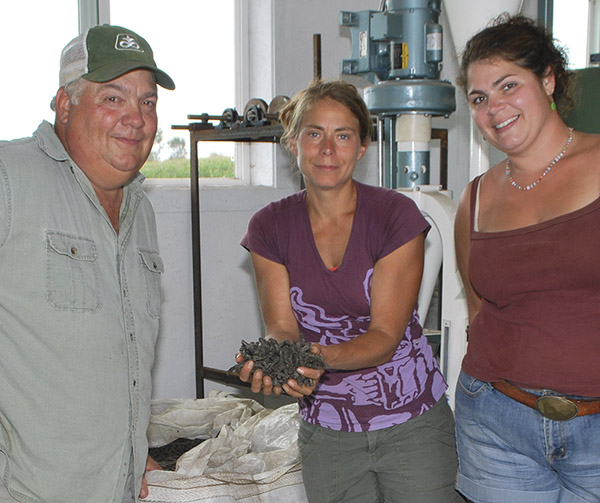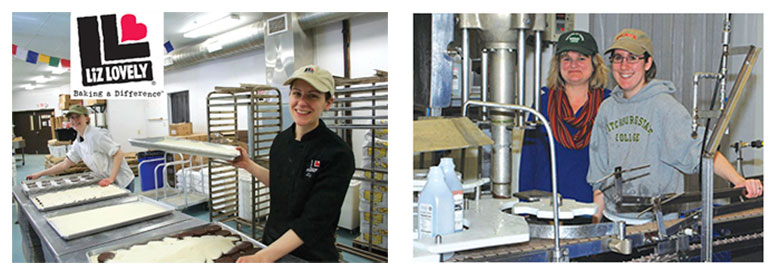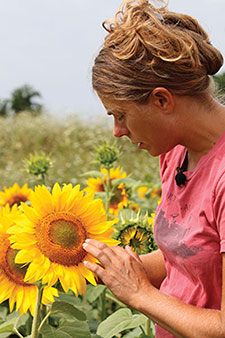Land-based Jobs Grow Fuel, Food and Future |
||||||||
Allison Teague |
||||||||
Roger Rainville (l), co-owner of Borderview Research Farm in Alburgh, Dr. Heather Darby (c), lead researcher with |
||||||||
In a recently published study of tweets—yes, they’re studying tweet-trends—a UVM research team found our state rated among the happiest in the nation, though generally the trend is spiraling down. And last year, when Gov. Peter Shumlin asked followers on Facebook and Twitter what they loved about Vermont, responses included maple syrup, clean water, beauty, skiing, swimming, and community. All shared one thing in common: a stable, healthy, and clean environment. Here “sustainable jobs” and “green economy” are not just words, they are being translated into policies and programs that help Vermonters live healthier lifestyles. Almost 20 years ago, seeing the economy’s interdependence with the health of both land and families, some Vermont legislators saw that our future lay along an ecological path. They created the Vermont Sustainable Jobs Fund (VSJF), according to the fund’s webpage, “to strengthen the statewide economic intersection of Vermont’s working landscape.” Since its establishment in 1995, VSJF and its programs have accelerated the development of Vermont’s green economy. It does this, its website explains, by providing “financing, technical assistance, and networking resources to Vermont businesses committed to creating jobs, products, and services in the fields of renewable energy, sustainable agriculture, and forestry.” The VSJF office is in Montpelier. Kahler became director in 2005. Previously director of the Peace & Justice Center in Burlington (1990-2002), she brought attention to the Vermont Job-Gap Study and the need for a living wage for Vermonters. After graduating from the Kennedy School for Government in 2003, she created and directed the Peer to Peer Collaborative, a mentoring program for small business CEOs sponsored by the Vermont Business Roundtable, and now part of the VSJF.
It’s Complicated “We’re not a jobs organization,” said VSJF communications director, Rachel Carter, in a recent interview, explaining that the misnomer is “one of the challenges” the organization faces. She said VSJF provides resources. In addition to peer-to-peer mentoring for businesses, these include technical support, and regional networks, as well as funding for market research and product research and development. It does feasibility studies for Vermont-based entrepreneurs whose businesses range from waste management and forest products to renewable energy. “We are not an easy organization to explain,” agreed Kahler. “But we can make things happen that other organizations can’t, because we are willing to deal with the complexities. We really try to do research and development at early stages of both project development, as well as market development.” The organization has created the Renewable Energy Atlas of Vermont, and supports the deployment of growth-stage capital through its Flexible Capital Fund. Its Farm to Plate Network, a coordinated network of over 250 food-related organizations, works to implement a legislatively directed plan to relocalize food production and distribution. VSJF also provides ongoing statistics on and analyses of Vermont’s farm system. Its Agriculture Development Program helps to build markets and infrastructure for Vermont value-added land-based enterprises. Businesses, such as Vermont Smoke and Cure in Hinesburg and Liz Lovely Bakery in Waitsfield, are Flex-Fund borrowers. VSJF’s programs promote sustainable agriculture and forestry, as well as renewable energy and green technologies. It may not be a “jobs organization,” but its ultimate goal is enabling local creation of local jobs, while also preserving a bountiful ecosystem. After almost 20 years of research and program development, tangible results are enabling farmers to reap the benefits. An example is VSJF’s bioenergy initiative aimed at increasing Vermont acreage for oilseed, and developing local processing to turn oilseed into biofuel, food, and meal for farm livestock. Carter explained that UVM has been researching this “for years.” Since 2004, UVM Extension and VSJF have worked with farmers to develop on-farm fuel facilities, including bioenergy. The overall goal is to gain energy and financial security on farms while reducing fossil fuel usage. Ten growers participated on 69 acres of land last year.
Growing Biodiesel Late in 2012, Borderview Research Farm in Alburgh began processing its oilseed sunflowers. VSJF’s Carter said that Borderview is working with UVM Extension “to produce biodiesel for their farm equipment.” Owner Roger Rainville and his daughter Natasha used biofueled equipment to harvest oil seeds grown on the project’s ten farms. Collected oilseed was brought back to Borderview’s state-of-the art biodiesel pressing and refining facility, and used for the first time in 2012. The farm-fresh-fuel project helps participating farmers replace higher cost diesel. Borderview Farm owns seed cleaners, storage containers, three types of oilseed presses, a biodiesel processor that can process 50 gallons of biodiesel daily, and a pelletizer that Rainville says it would never have been able to afford without federal renewable energy earmarks funneled, initially, through VSJF. The farm extracted 5,000 gallons of oil last year, cost-shared among the farms, with nothing going to waste. The leftover product was turned into meal--more than 17 tons of it--for the farm’s beef stock. This year, however, Rainville said the seed crop yield fell short of the 3,000-gallon goal, owing to heavy rains early in the season. He has enough on his farm to produce around 500 gallons. It is still a profitable project, he stated, given the near-$4 a gallon price of regular diesel fuel, but only his farm will benefit. Rainville will also process meal for his herd of 20 beef cattle. The UVM Farm Fresh Fuel pilot project, slated to end this year, will likely be extended for another year, according to Rainville. The farm will also put up around 1,000 tons of corn silage and 7,000 bales of hay to sell this year, he said.
Why Invest? Janice St. Onge is the deputy director of VSJF, and also president of the VSJF Flexible Capital Fund. Her background includes financial services, higher education, and state government, including directing the Vermont Business Center at UVM and business technology development at the Vt. Department of Economic Development. A former judge for the Freestyle Ski World Cup, she’s also co-founder of the Stowe Energy and Climate Action Network and a 2004 alumna of the Snelling Center for Government. The Flexible Capital Fund is an L3C (a low-profit limited liability company), she said, a new company designation adopted by Vermont and eight other states to denote a for-profit business that serves a public good. It allows private foundations to meet their 5 percent obligation for charitable giving, demanded by the IRS, by investing in low-profit L3Cs, as well as contributing to non-profit organizations. St. Onge explained how she gets funders interested. “They understand that you have to be looking down the road at where the future is headed. We have been able to convince enough funders that there is a value to looking farther ahead, and investing in future conditions as markets strengthen.” She added, “All of our funders are from Vermont or New England.” St. Onge said “slow money” principles are core to the mission of VSJF and how they choose which projects to support (See Vermont Woman’s slow money article, “Creating Real Wealth.”) The fund provides venture capital to businesses in innovative ways. Its Flexible Capital Fund “is a mission-based investment fund that provides ‘equity-like’ financing in the form of royalty loans and subordinated debt,” said St. Onge. What does that mean? Venture capital from a funder more usually requires issuing stock in a company’s equity or net value. Royalty loans, by contrast, commit only a percentage of return on the company’s revenue stream for a period of time. Likewise, subordinated debt is unsecured debt, similar to that of credit cards. It demands no collateral. These are terms for venture capital that small businesses can seldom get. St. Onge noted that the fund is not legislatively mandated, but is managed by the Vermont Jobs Fund.
Smart Networks Many businesses are functioning now after working up from product research and development, market research and development, and CEO training with VSJF–a process that can take years from start to finish. And, she noted, as a result of VSJB’s educational efforts, more Vermont products, such as wood furniture, are being bought by Vermont institutions. VSJF-like programs are being used throughout New England, according to Kahler. This education component is another way VSJF sustains itself. Educational consulting furthers the spread of regional networking. “We’re not trying to create a national model, we want to create one in Vermont and link regionally,” Kahler said. “It is important for us to share what we are doing here.” VSJF’s approach, said Kahler, is to present its programs in context: “This is what worked for us. Now what will work for you?” And this approach happens to be connected to a growing interest in “network weaving,” a concept that fundamentally expresses the core values at work in Vermont and VSJF. Network weaving is “the intentional practice of helping people to build and connect to more relationships of trust and value, by virtue of being genuinely interested in building and connecting oneself to more relationships of trust and value,” according to Bill Traynor in his The Essence of Weaving, published in 2010. Kahler explained why this way of connecting works for VSJF. “It mimics ecosystems. It is a natural way that we connect. We live as social beings” She remarked, “It probably took something like Facebook to go mainstream to be understood that this is how we operate as humans. We like to be connected to one another. Facebook, LinkedIn, and other [social networks] have provided the technology to accelerate the ability to be connected.” VSJF has found a way to leverage this concept successfully, becoming a model for a green economy and sustainable future, not just in Vermont, but connecting throughout New England.
|
||||||||
Allison Teague is Vermont Woman’s environmental writer and an artist and photographer. She lives and works in southeastern Vermont.
|
||||||||




